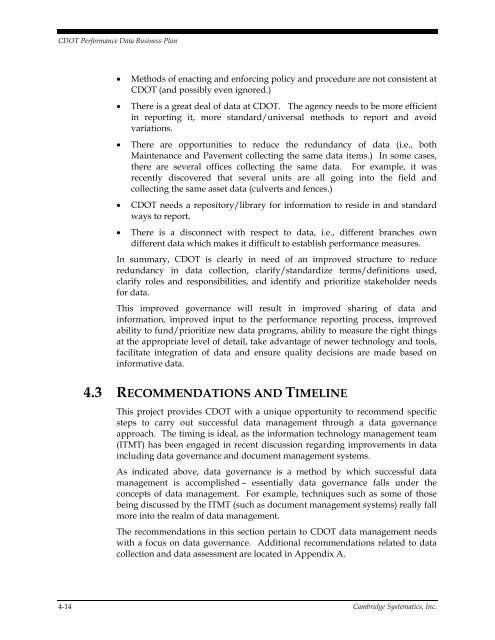CDOT Performance Data Business Plan - Cambridge Systematics
CDOT Performance Data Business Plan - Cambridge Systematics
CDOT Performance Data Business Plan - Cambridge Systematics
Create successful ePaper yourself
Turn your PDF publications into a flip-book with our unique Google optimized e-Paper software.
<strong>CDOT</strong> <strong>Performance</strong> <strong>Data</strong> <strong>Business</strong> <strong>Plan</strong><br />
<br />
<br />
<br />
<br />
<br />
Methods of enacting and enforcing policy and procedure are not consistent at<br />
<strong>CDOT</strong> (and possibly even ignored.)<br />
There is a great deal of data at <strong>CDOT</strong>. The agency needs to be more efficient<br />
in reporting it, more standard/universal methods to report and avoid<br />
variations.<br />
There are opportunities to reduce the redundancy of data (i.e., both<br />
Maintenance and Pavement collecting the same data items.) In some cases,<br />
there are several offices collecting the same data. For example, it was<br />
recently discovered that several units are all going into the field and<br />
collecting the same asset data (culverts and fences.)<br />
<strong>CDOT</strong> needs a repository/library for information to reside in and standard<br />
ways to report.<br />
There is a disconnect with respect to data, i.e., different branches own<br />
different data which makes it difficult to establish performance measures.<br />
In summary, <strong>CDOT</strong> is clearly in need of an improved structure to reduce<br />
redundancy in data collection, clarify/standardize terms/definitions used,<br />
clarify roles and responsibilities, and identify and prioritize stakeholder needs<br />
for data.<br />
This improved governance will result in improved sharing of data and<br />
information, improved input to the performance reporting process, improved<br />
ability to fund/prioritize new data programs, ability to measure the right things<br />
at the appropriate level of detail, take advantage of newer technology and tools,<br />
facilitate integration of data and ensure quality decisions are made based on<br />
informative data.<br />
4.3 RECOMMENDATIONS AND TIMELINE<br />
This project provides <strong>CDOT</strong> with a unique opportunity to recommend specific<br />
steps to carry out successful data management through a data governance<br />
approach. The timing is ideal, as the information technology management team<br />
(ITMT) has been engaged in recent discussion regarding improvements in data<br />
including data governance and document management systems.<br />
As indicated above, data governance is a method by which successful data<br />
management is accomplished – essentially data governance falls under the<br />
concepts of data management. For example, techniques such as some of those<br />
being discussed by the ITMT (such as document management systems) really fall<br />
more into the realm of data management.<br />
The recommendations in this section pertain to <strong>CDOT</strong> data management needs<br />
with a focus on data governance. Additional recommendations related to data<br />
collection and data assessment are located in Appendix A.<br />
4-14 <strong>Cambridge</strong> <strong>Systematics</strong>, Inc.

















